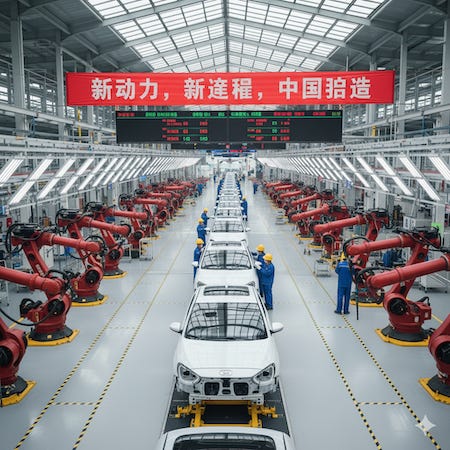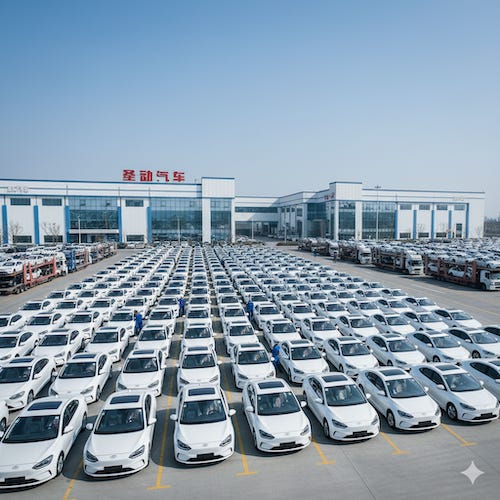In 2023, the Ford CEO flew to China and tried a Chinese EV.
This was an electric SUV made by a company called Changan.
Chinese cars had been laughed at until very recently.
It was not only established companies’ CEOs who considered Chinese EVs a non-threat. Back in 2011, Tesla was desperate to sell its first commercial car. But its CEO, Elon Musk, giggled when asked about Chinese EV maker BYD.
The CEO of Ford reportedly said that Chinese EVs were an existential threat to them.
That is how good the Chinese EV makers had gotten in only a few years.
A year later, he admitted to using a Xiaomi SU7 in the USA (yes, the same company that makes phones).
He had been using the newly launched car for 6 months and was loving it to the point where he didn’t want to give it up.
Chinese EVs are heavily tariffed to the point that they may be considered banned in the US.
Ford’s CEO had one imported specially – to try out the car.
Various Chinese EVs have been seen inside numerous European car factories. They are all supposedly being tested and evaluated.
An SU7 was even spotted inside the Ferrari factory. The cheapest Ferrari model costs around 6 times more than the SU7.
That is how seriously Western brands are taking Chinese EVs.
How did Chinese EVs get so good?
Modern Chinese EVs are a perfect showcase of how China and its policy-making work.
It starts with China’s concerns around energy security.
Ten Cities, Thousand Cars
Like many other major countries, China depends heavily on imported petroleum.
About 80% of Chinese crude oil is shipped via the Indian Ocean. A country that wants to disrupt the Chinese economy can target this shipping route — it will be very effective.
The Chinese are wary of this.
China has been building power plants extremely aggressively through the decades.
In the 1990s, it had the 3rd biggest demand for electricity in the world.
The first was the US. The second was the European Union. India was in 4th place.
Today, China is first by a huge margin.
China: 10,000 TWh, USA: 4,400 TWh. EU: 2,700 TWh.
With electricity production reaching new highs, they could reduce their dependence on crude oil and petrol products.
But there was a problem. Cars need petrol products. And China was the world’s biggest car market.
In 2009, the Chinese government came up with a plan to promote the use of electric cars and hybrid cars.
They called this, the ‘Ten Cities, Thousand Cars’ plan.
1,000 EVs per city, 10 cities per year. That was the goal.
The rollout was in the form of subsidies. These were initially public transportation — mainly buses, cabs, etc. In addition to that, the government also tried to increase the charging and maintenance network.
Later, this subsidy was extended to private vehicles also.
The model worked.
On noticing early successes, the Chinese government introduced tax breaks for EVs, driving up demand further.
Until 2014, the US was the biggest market for EVs. In 2015, that changed — China became the world’s biggest market for EVs.
This was coupled with rapid infrastructure and charging network expansion.
Later, the goal was updated. Within 10 years, they would have over 5 million EV and hybrid cars on Chinese roads by the end of 2020.
This target was achieved successfully.
Demand & Competition
This government push was enough to create a huge domestic market for EVs in China.
Not only private buyers, but the government itself started placing bulk orders for EVs.
With a domestic market, companies felt drawn to the prospect of being an early mover in the EV space.
China is home to some of the biggest auto-parts factories in the world. The move seemed easier.
There’s another government aided side to this.
In China, provinces, cities, city-states, states, etc are extremely competitive. The government bodies running each of these are rewarded more based on the tax they earn, GDP growth they cause, and so on.
So it is common to see the government rolling out tax breaks, subsidies, discounted land, and so on for EV makers.
Auto companies tend to be big job creators. They also pay a large amount of taxes, and lead to the trickling down of jobs and wealth.
For this reason, competitive regional governments tend to support EV companies from their respective regions.
Providing cheap loans, subsidies on specific activities like R&D, tax breaks, and even buying stakes in the company itself is common.
The incentives were so tempting, companies that were not full-stack car making companies also started making cars.
Cars are never made by one company. They’re always an assembly of parts made by various companies. This made it easier for newer companies to break into the industry.
This gives birth to companies that are well-funded, have access to a vast network of expert parts suppliers, and have risk taking ability.
These are in some ways, local-government backed companies.
The good support, and intense competition within the industry led to products that kept getting better at every iteration.
They made better cars at exceedingly low prices.
Soon they were able to make cars that were cheaper and better in many respects than the cars made in the West and other countries like Japan and South Korea.
Biggest
The number of cars produced was ballooning.
A natural next step was exporting. They started exporting.
Western countries, including the US swiftly increased tariffs and barriers on the sale of Chinese EVs.
European, Korean, and American companies are now pushing aggressively towards a more electric line of product offerings.
One criticality is that while that happens, these companies remain heavily dependent on Chinese parts suppliers for critical EV components.
The world’s biggest EV battery supplier, CATL, is a Chinese company. The world’s biggest EV car maker is BYD — another Chinese company.
About 12 million EV cars were made in 2024.
10 million of those were made by Chinese companies.
Quick Takes
+ India’s industrial production rose 4% year-on-year in Aug. Production increased for mining (+6%), electricity (+4.1%), and manufacturing (+3.8%): MoSPI.
+ The Indian Army issued a Rs 30,000 crore tender for the indigenous ‘Anant Shastra’ (QRSAM) air-defence system. The missile, developed by DRDO, will be co-produced by various companies including BEL and Bharat Dynamics: as per various media reports.
+ The Nifty 50 was reshuffled today (done every 6 months). InterGlobe Aviation (IndiGo) and Max Healthcare were added. Hero MotoCorp and IndusInd Bank were removed.
+ India’s external debt rose to $747.2 billion in the April-June quarter (vs $736.3 billion in the Jan-March quarter).
+ The RBI kept the repo rate unchanged at 5.5%.
+ The central government approved a 3% increase in the Dearness Allowance for government employees and pensioners, applicable from 1 July 2025.
+ The central government approved 57 new Kendriya Vidyalayas (KVs) across India, with an estimated cost of Rs 5,862.55 crore over 9 years.
+ The central government approved the widening of Kalibor-Numaligarh NH-715 in Assam to a four-lane highway, at a cost of Rs 6,957 crore.
+ India’s GST collection rose 9.1% year-on-year in Sept (vs 6.5% in Aug) to Rs 1.89 lakh crore.
+ India’s manufacturing PMI fell to 57.7 in Sept (vs 59.3 in Aug). This means manufacturing activity rose less in Sept than in Aug.
+ SEBI has introduced Validated UPI Handles and a SEBI Check tool for investors to authenticate UPI IDs and bank details of intermediaries to reduce fraud risk.
+ The Euro Area’s unemployment rate rose to 6.3% in Aug (vs 6.2% in July).
+ India’s forex reserves fell $2.33 billion to $700.23 billion in the week that ended on 26 Sept.
+ The US President Trump directed US colleges to limit international undergraduate students to 15% total, and no more than 5% from any single country, or risk losing government funding.
The information contained in this Groww Digest is purely for knowledge. This Groww Digest does not contain any recommendations or advice.
Team Groww Digest




